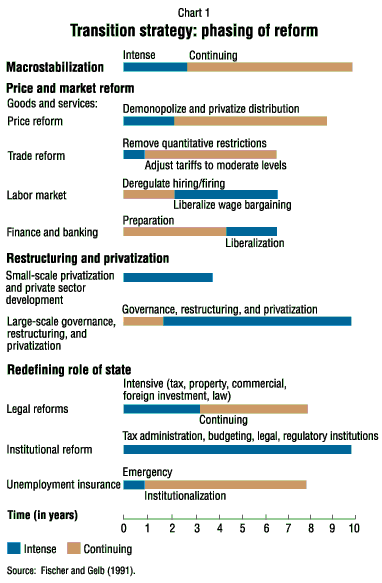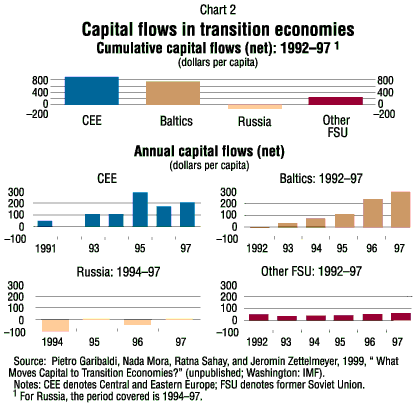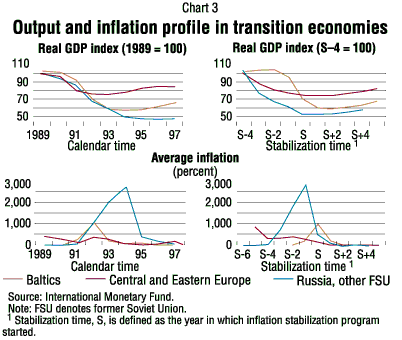 About F&D Subscribe Back Issues Write Us Copyright Information Use the free Adobe Acrobat Reader to view a pdf file of this article
|
Taking Stock Stanley Fischer and Ratna Sahay Economic performance has differed widely among the transition economies. The best performers are countries that were the most committed to reform at the start and that have carried out reforms rapidly and consistently. When reform began 10 years ago in Central and Eastern Europe, the Baltics, Russia, and the other countries of the former Soviet Union, output was expected to fall as a result of economic stabilization programs and the reallocation of resources from unproductive to productive sectors. The view was that, as reform policies took hold and new sectors began to develop, aggregate output would begin to grow. Output was expected to grow more rapidly in the less advanced economies, and there would be a closing of income gaps or even, eventually, convergence. Output did fall in all 25 countries at the start of transition. The extent of the collapse, however, exceeded expectations: output had fallen by more than 40 percent, on average, by the time it bottomed out. By 1999, output was growing in virtually all of the 25 economies, though glacially in some (Table 1). Needless to say, the quality of output data, especially in the early transition years, was questionable because output and growth rates were most likely understated owing to the only partial inclusion of the nonstate sector and the emergence of the nontaxed economy. Despite these concerns, we believe that the statistical evidence sheds some light on the early transition experience.
In many countries, the pickup in growth rates since the output troughs has been impressive. On a cumulative basis, most noteworthy were the recoveries in Albania, Poland, Armenia, the Slovak Republic, Georgia, and Slovenia, in that order. Average growth rates were higher in the countries of the former Soviet Union than in Central and Eastern Europe, owing mainly to the much larger initial output declines in the former group. Nonetheless, by 1999 very few countries had surpassed their pretransition levels of output. Only Albania, Poland, the Slovak Republic, and Slovenia had higher measured output in 1999 than in their pretransition year. On average, by 1999 the Central and Eastern European countries had recovered about 90 percent of their pretransition output, the Baltics about 70 percent, and Russia and the other countries of the former Soviet Union, 60 percent. Inflation and stabilization Most countries embarked on transition with a monetary overhang and a need to liberalize prices. Inflation was either already present or a major threat. Beginning with Poland in 1990, by 1995 all 25 countries except Turkmenistan had introduced stabilization policies (Table 2). By 1999, annual inflation rates, which had ranged from 26 percent in Hungary to 57,000 percent in Georgia, had been reduced to single digits in about half of the countries. Bulgaria, Estonia, and Lithuania, which have currency boards, have had the most impressive anti-inflationary performances.
An important element in the initial stabilization strategies was the choice of exchange rate regime. Countries in Central and Eastern Europe and the Baltics opted for either a fixed or a flexible regime. Russia and the other countries of the former Soviet Union formally announced flexible regimes, although many countries began to peg their currencies, formally or informally, to the U.S. dollar or the deutsche mark. With most exchange rates fixed, either explicitly or de facto, inflation rates began to decline rapidly. By 1999, most of the transition countries had reduced inflation to relatively low levels, although it had begun to climb again in a few of the former Soviet republics. Today, all but four countries have adopted flexible exchange rate regimes, with Poland as the leading example of a successful exit from a peg. Fiscal balances also deteriorated sharply at the start of transition. While fiscal consolidation occurred in most countries during the transition, no clear relationship between fiscal balance and growth is evident. This is because, in some countries, higher public expenditures were associated with reforms that were beneficial for growth (for example, those dealing with nonperforming loans of the banking sector, clearing past fiscal arrears, and restructuring the social sector). At the same time, in some of the former Soviet republics, underlying the sharp fiscal contraction were very large revenue declines and ad hoc expenditure cuts, which undermined the authorities' capacity to implement reforms. What is clear from the data, however, is that countries that had both persistent fiscal deficits and slow structural reforms were unable to sustain the process of stabilization. This is most evident in Russia, but is also apparent in Belarus, Tajikistan, and Uzbekistan. The performance of the transition economies in bringing inflation down from very high levels has been impressive. The subsequent move in most countries to flexible exchange rate regimes seems reasonable in view of the recent lessons learned—notably in Russia—regarding the high costs associated with fixed regimes in the new global environment of heightened financial vulnerabilities and exposure to international capital markets. On the fiscal front, the average country is far more indebted today than before. Consequently, it will be much more difficult to sustain large deficits unless reforms and growth accelerate. Transition strategies Soon after transition began, a consensus emerged on the main elements of a transition strategy, as outlined by Fischer and Gelb in 1991 (Chart 1). We are struck particularly by the fact that this consensus included elements that are now thought to have been overlooked at the initial stages, for instance, legal reforms. The substantial length of time envisaged for both institutional and enterprise reforms was also predicted. Interestingly, trade reforms were expected to be more gradual than was actually the case.
 Several points of controversy emerged within the overall strategy, particularly over so-called shock therapy and sequencing. The controversies over shock therapy related mainly to macroeconomic stabilization, price and trade liberalization, and the pace at which privatization could be attempted, while the debates over sequencing centered on the argument that some reforms were preconditions for others. Those who advocated moving rapidly ahead with reforms based their arguments not only on economics—that the cumulative output loss would be smaller if actions were taken more quickly—but also on political economy grounds. Particularly influential was the concept of "extraordinary politics" put forward by Leszek Balcerowicz, the former Polish finance minister, who believed there was more opportunity to implement reforms at the start of the transition. As time went on, it became evident that rapid policy action was possible in some areas of reform—liberalizing prices and trade, stabilizing inflation, and achieving small-scale privatization—while, in others, moving faster was simply not possible. It is also clear that some reforms are complementary with others—for instance, privatization is more likely be productive if the right legal framework, or financial system, or both are in place. Aid and capital flows Most proponents of reform took it for granted that external financial assistance would be needed at the early stages of transition to encourage reform and sustain the reformers and also to compensate for these countries' lack of experience in running a market economy. Despite initial talk, the launching of the equivalent of a Marshall Plan for transition economies never materialized. Rather, external assistance was provided primarily by the international financial institutions, the European Union, and bilateral donors, and in smaller amounts than originally discussed. Per capita capital inflows to transition countries in the 1990s were similar to those to Latin America and the more advanced Asian economies, and much greater than those to other developing countries. (Russia is the only country in the entire region that has been a net exporter of capital.) The composition and distribution of inflows was highly uneven, however (Chart 2). Long-term inflows were significantly larger than short-term ones. Central and Eastern Europe and the Baltics received greater inflows than Russia and the other countries of the former Soviet Union. There was a large recourse to exceptional financing (debt reduction and restructuring and official aid) at the beginning of the transition period and a subsequent reorientation of capital flows toward foreign direct investment and other private flows: that is, private sector inflows speedily replaced official assistance once reforms were being successfully implemented.
 Explaining growth performance The greatest drop in output occurred in the year transition began, and output continued to decline before stabilization took effect. After stabilization programs were implemented, output began to grow after two years, on average (Chart 3). As analyzed in Berg, Borensztein, Sahay, and Zettelmeyer (1999), the initial decline in output is associated more with disorganization and adverse initial conditions than with tight stabilization policies or progress in structural reforms. Although their economic systems and literacy rates were similar, the 25 countries' economic characteristics varied widely when they embarked on transition. Some—such as Azerbaijan, Kazakhstan, Russia, and Turkmenistan—had abundant natural resources. Countries of Central and Eastern Europe and the Baltics generally enjoyed higher per capita incomes and were in a better position to reorient their trade toward the industrial countries. A simple regression analysis reveals that, among a number of initial conditions (such as resource endowments, share of agriculture in GDP, years under communism, secondary school enrollment, dependency on trade, and overindustrialization), only two—the number of years under communism and secondary school enrollment—account for much of the transition economies' subsequent output performance.
 The regression analysis also shows that macroeconomic stabilization was followed by growth, with structural reforms playing the predominant role in bringing about sustained recovery through their effect on the private sector. In short, it has been found that countries that stabilized, and that privatized and reformed faster, grew faster, with structural reforms paving the way for the recovery. The larger initial decline in output in the Commonwealth of Independent States (CIS) can be explained mainly by slower structural reforms and, to a lesser extent, by adverse initial conditions. It is noteworthy that the Baltic countries and Poland had some of the worst initial conditions yet performed well. This demonstrates that countries that adopted anti-inflationary policies and faster structural reforms could overcome adverse starting conditions. Private sector development Private sector development moved forward fairly rapidly in most countries—whether through privatization of state-owned firms or the emergence of new firms—and was a key element in reform. Some countries chose the route of mass privatization through voucher schemes (for example, the former Czechoslovakia and Russia), while others chose to sell state-owned enterprises (Hungary and Poland). The imposition of hard budget constraints on enterprises, whether public or private, appears to be important in determining success. Insider privatization, whether controlled by workers (as in the former Yugoslavia) or by managers (as in Russia), does not seem to have led to restructuring. Small-scale privatization, whether through vouchers or through sale to insiders, was generally successful. Productivity in private enterprises appears to be higher than in state enterprises, and survey data in Estonia show that new firms are more productive than privatized state firms. Also, experience from Slovenia and the Czech Republic indicates that foreign-owned firms perform better than domestic privatized ones. For these reasons, the strategy of starting with rapid small-scale privatization and taking longer to privatize large enterprises could had been more successful, provided the larger companies had been sold. For instance, Hungary's slower and more firm-specific approach appears ex post to have been more successful than the more rapid Czech voucher scheme. Governance Corruption and governance problems remain endemic in some countries, while they are far less prevalent in others. Some countries have had considerable success in reducing corruption through tax reform, improved tax administration, and regulatory and civil service reform. It is also clear that in some countries, owing either to unrealistic expectations of absorptive capacity or to domestic political constraints, considerable external technical assistance in the areas of legal reform, financial markets, central banking and fiscal systems, and the other aspects of modern government have brought limited benefits. Consequently, the flow of foreign as well as domestic investment has slowed and capital flight has been encouraged, with growth suffering as a result. While the cure for governance-related problems lies mainly in domestic policies, external assistance can encourage transparency and strengthen institutions by making future assistance conditional on progress in these areas. It is reasonable to hope that the same process that undermined support for the communist system might produce a political backlash against corruption for holding back economic growth and creating social inequalities. Russia Russia's experience is unique. The question is why, despite a promising start in 1992, rapid privatization in 1994-95, and stabilization in 1995, subsequent reforms have been slow. The answer lies largely in Russia's failure to drive ahead with reforms after the 1996 elections, when powerful vested interests strengthened their hold on political and economic power, deepening corruption. Russia, like many countries, seems to have suffered from the curse of natural resources—ready sources of wealth that were available without much productive effort and prizes to be fought over, rather than investments to develop and foster. Russia's failure to solve its fiscal problems, combined with easy access to external capital and continuing capital flight, led to an excessively large fiscal deficit and growing short-term public debt. When the external environment worsened—as oil prices fell and foreign financing dried up—in the context of a weak domestic banking system and an inflexible exchange rate, a financial collapse could not be prevented. If reforms had been vigorously pursued after 1996, the collapse could have been avoided. The question now is when the political authorities will decide to renew reforms and improve governance. Despite the 1998 collapse, the Russian government has not turned inward but continues to maintain economic relations with the rest of the world. Recent election results confirm the consensus on the irreversibility of transition and the establishment of a market economy. Looking forward, much remains to be done, particularly in restructuring the industrial and banking sectors, eliminating the problems of nonpayment and barter, reforming the tax system, strengthening the social safety net, and reforming agriculture. Determinants of reform What are the characteristics of a successful transition? Statistical analysis reveals that the behavior of output has been strongly influenced by the extent of stabilization and reform, relative to initial conditions—that is, by and large, radical reforms have worked. The benefits of a successful transition are clear. If the policies to ensure growth are well known, why are they not adopted in countries where reform is lagging? The answer lies in the realm of political economy. The faster reformers were closer to Western Europe, had spent fewer years under a communist regime, and were more advanced economically when they fell under Soviet control or when the transition process began. In addition, it has to be recognized that the prospect of joining the European Union appears to have been a powerful spur to reform, an incentive that does not apply to CIS countries. The main challenge for the supporters of reform has been and is to find ways to build and sustain a reform coalition.
Suggestions for further reading: Andrew Berg, Eduardo Borensztein, Ratna Sahay, and Jeromin Zettelmeyer, 1999, "The Evolution of Output in Transition Economies," IMF Working Paper 99/73 (Washington: International Monetary Fund). Stanley Fischer and Alan Gelb, 1991, "Issues in Socialist Economy Reform," Journal of Economic Perspectives, Vol. 5 (Fall), pp. 91-105. Stanley Fischer and Ratna Sahay, 2000, "The Transition Economies after Ten Years," IMF Working Paper 00/30 (Washington: International Monetary Fund). John Nellis, 1999, "Time to Rethink Privatization in Transition Economies?" IFC Discussion Paper No. 38 (Washington: International Finance Corporation). Charles Wyplosz, 1999, "Ten Years of Transformation: Macroeconomic Lessons," paper prepared for the Annual World Bank Conference on Development Economics (ABCDE), April 28-30 (Washington: World Bank).
|
||||||||||||||||||||||||||||||||||||||||||||||||||||||||||||||||||||||||||||||||||||||||||||||||||||||||||||||||||||||||||||||||||||||||||||||||||||||||||||||||||||||||||||||||||||||||||||||||||||||||||||||||||||||||||||||||||||||||||||||||||||||||||||||||||||||||||||||||||||||||||||||||||||||||||||||||||||||||||||||||||||||||||||||||||